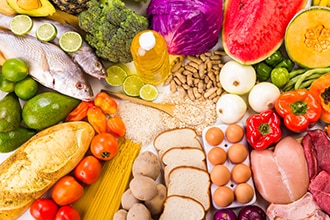
The Whole30 diet is a way to reset your metabolism and cleanse your digestive tract. You won't have the option to eat fast food or junk food. Additionally, you will have to stay away from soy and dairy. However, you can still eat plenty vegetables and fruits which can be an excellent alternative to fast food. The list also includes recipes for healthy snacks and meals. These tasty and nutritious treats are easy to make without sacrificing the flavor you love.
The Whole30 diet allows you to eat various kinds of fruits, veggies, and fats. Although you don't have to avoid all foods, the Whole30 diet does not require you to. The Whole30 website lists the allowed and banned foods. Besides, the free chart is available for download, so you can print it out, stick it in your wallet, or save it to your phone.
However, you can't eat pre-packaged foods. But, you can get them at a store that stocks them. Although they technically conform to the Whole30 diet guidelines, they are not part of the Whole30 foods list. Instead, it focuses on eating more natural and unprocessed foods - such as fruit, nuts, and seeds. While you are eating more vegetables than ever before, processed meat will not be available to you. So make sure to read the labels.

The whole 30 plan encourages eating more vegetables than usual. They are higher in nutrients and fiber. The Whole30 diet won't allow you cowboy ribeyes, but vegetables can be eaten for up to 30 days. Fruits are high in natural sugar so you should not make fruit a mainstay of your diet. Many people don’t realize they’re overeating sugar.
You can eat as many vegetables and fruits as you want but you won't be allowed to eat potatoes on the whole30 diet. You can eat fruits and vegetables without restrictions, but you should avoid processed cheese and red meat, which are known to cause bloating. But even though you may have to buy these items from a grocery store that carries them.
Other Whole30 friendly foods include fish and eggs. They can be used in stir-fries and salads. But, it's important not to consume too much. If you choose the right foods, you can still enjoy them in moderation. Although you might not like chocolate, you still can eat almond butter or carrots. You can also use almond butter or vegetable juice in moderation.
The Whole30 diet may not work for everyone. However, it can help you detoxify and lose weight. It's also a great way to start eating better and feel better. There are a few things you need to know before you try it. It is a good idea to eat these foods often if you are unsure of what foods you should include.

Coconut oil can also be used to fry bananas or plantains. This is allowed on Whole30. Coconut oil can be used to fry plantains and bananas, but avoid overripe bananas. Avocados are an excellent addition to the Whole30 diet. They can be used to curb your cravings. The Whole30 diet is best to be consistent for a few months to reap the benefits.
The Whole30 diet is a great way to get rid of bad eating habits. You can avoid sugary processed foods. Your body can feel good by eating whole, unprocessed foods. Whole30 doesn't require that you count calories, weigh yourself, or measure portions. Whole30 can be performed without these restrictions. But you must make sure that you don't have any side effects while you're on the diet.
FAQ
What is the best food for me?
Many factors influence which diet is best for you. These include your age, gender and weight. You should also consider how much energy your exercise consumes, whether you like low-calorie or high-calorie foods, and what you enjoy in terms of eating fruits and veggies.
If you are trying to lose weight, then you may want to try intermittent fasting. Intermittent fasting is a way to eat only certain meals during the day instead of three large meals. This approach may prove to be more beneficial than traditional diets that have daily calorie counts.
Some studies suggest that intermittent fasting may improve insulin sensitivity and reduce inflammation, which can lead to improved blood sugar levels and reduced risk of diabetes. Research also shows that intermittent fasting may increase fat loss and improve overall physique.
What can you do if your immune system is weak?
The human body is composed of trillions if not billions of cells. Each cell works together to create organs and tissues that fulfill specific functions. A cell that dies will be replaced by another. Chemical signals, called hormones, allow cells to communicate with each other. Hormones control all bodily functions, including growth, development, metabolism, immunity and immune system.
Hormones, chemicals that are secreted throughout the body by glands, are chemicals. They are chemicals that travel through the bloodstream and function as messengers to control how our bodies work. Some hormones can be produced in the body, while others may be made outside.
The hormone-producing glands release their contents into bloodstream. This is when hormone production starts. Once hormones are released, they move through the body to reach their target organ. Some hormones may only remain active for a limited time. Some hormones remain active for longer periods of time and can continue to have an impact on the body's function long after they are gone.
Some hormones are produced in large quantities. Others are made in small quantities.
Some hormones only are produced during certain periods of life. For example, estrogen can be produced during puberty or pregnancy. Estrogen helps women develop breasts, maintain bone density, and prevent osteoporosis. It promotes hair growth as well as keeping skin soft and smooth.
What is the difference among a virus or a bacterium and what are their differences?
A virus is a microscopic organism which cannot reproduce outside of its host cell. A bacterium (or single-celled organism) reproduces by splitting itself into two. Viruses have a very small size (about 20 nanometers), while bacteria is larger (up to one micron).
Viruses are often spread through contact of infected bodily fluids like saliva, urine or semen. Bacteria is usually spread directly from surfaces or objects contaminated with bacteria.
Viruses can get into our bodies through cuts and scrapes on the skin, bites, and other injuries. They may also enter through the nose, mouth, eyes, ears, vagina, rectum , or anus.
Bacteria can be introduced to our bodies by cuts, scrapes or burns. They can also enter our bodies from food, water, soil, dust, and animals.
Both viruses and bacteria can cause illness. However, viruses cannot reproduce within their hosts. They can only infect living cells and cause illness.
Bacteria can spread within the host and cause illness. They can invade other areas of the body. That's why we need antibiotics to kill them.
Do I need calories to count?
It is possible to wonder "What diet is best for me?" or "is counting calories necessary?" This depends on your health and lifestyle.
The Best Diet For Me: Which One Is Right?
The best diet depends on me, my health, my goals, my preferences and my overall lifestyle. There are many options, both good and bad. Some work well for certain people while others don't. So what do I do? How can I make the right choice?
This article aims at answering these questions. It starts with a brief introduction of the different types of diets available today. Then we will discuss the pros & cons of each kind of diet. The final step is to determine which one is right for you.
Let's look at some of the main types of diets to get started.
Diet Types
There are three types of diets available: ketogenic, high-protein, and low fat. Let's briefly discuss them below.
Low Fat Diets
A low fat diet is a diet that restricts the amount of fats consumed. This is achieved by reducing saturated fats like butter, cream cheese, and other dairy products. and replacing them with unsaturated fats (olive oil, avocados, etc.). Low fat diets are often recommended to those who wish to lose weight quickly. However, this kind of diet may cause problems such as constipation, heartburn, and indigestion. In addition, it may lead to vitamin deficiencies if a person doesn't get enough vitamins from their food.
High Protein Diets
High-protein diets limit carbohydrates and favor proteins. These diets often have higher levels of protein than most other diets. They are meant to help build muscle mass and burn more calories. They may not be able to provide sufficient nutrition for people who need it. They are also very restrictive, so they might not be appropriate for everyone.
Ketogenic Diets
Ketogenic diets also go by the name keto diets. They are high on fat but low in carbs and proteins. They are commonly used by athletes and bodybuilders, as they allow them train harder and more frequently without getting tired. But, they require strict adherence to avoid negative side effects like nausea, headaches, and fatigue.
Statistics
- According to the Physical Activity Guidelines for Americans, we should strive for at least 150 minutes of moderate intensity activity each week (54Trusted Source Smoking, harmful use of drugs, and alcohol abuse can all seriously negatively affect your health. (healthline.com)
- This article received 11 testimonials and 86% of readers who voted found it helpful, earning it our reader-approved status. (wikihow.com)
- Extra virgin olive oil may benefit heart health, as people who consume it have a lower risk for dying from heart attacks and strokes according to some evidence (57Trusted Source (healthline.com)
- According to the 2020 Dietary Guidelines for Americans, a balanced diet high in fruits and vegetables, lean protein, low-fat dairy and whole grains is needed for optimal energy. (mayoclinichealthsystem.org)
External Links
How To
What does the term "vitamins" mean?
Vitamins are organic substances found naturally in food. Vitamins are essential for our bodies to absorb nutrients from the foods we eat. The body cannot make vitamins; therefore, they must be obtained from food.
There are two types of vitamins: water soluble and fat soluble. Water-soluble vitamins dissolve easily when they are dissolved in water. Some examples include vitamin C,B1 and B2 vitamins (thiamine), B2 and riboflavin, B3 and B6 vitamins (niacin), folic acids, biotin, pantothenic acids, and cholesterol. Fat-soluble vitamins are stored in the liver, fatty tissue and kidneys. Some examples include vitamin D and E, K, A and beta carotene.
Vitamins are classified according to their biological activity. There are eight major types of vitamins:
-
A - Essential for healthy growth and health maintenance.
-
C is important for nerve function and energy production.
-
D - Essential for healthy teeth and bones.
-
E - Required for good vision & reproduction
-
K - required for healthy muscles and nerves.
-
P – vital for building strong bones.
-
Q – aids digestion of iron and iron absorption
-
R is required for the production of red blood cells.
The recommended daily allowance of vitamins (RDA), varies according to age, gender, physical condition, and other factors. The U.S. Food and Drug Administration sets RDA values.
For adults 19 years and over, the RDA of vitamin A is 400mg per day. Because it is essential for the development of the fetus, pregnant women should consume 600 micrograms per daily. Children ages 1-8 require 900 micrograms per day. Babies under one-year old require 700 mg per day. Between 9 and 12 years of age, however, this drops to 500 mg per day.
Children aged 1-18 years need 800 micrograms daily, while children overweight require 1000 micrograms per days. Children who are severely obese or underweight will need 1200 micrograms each day.
2200 mg of vitamin A per day is required for children aged 4-8 who have been diagnosed by anemia.
Adults over 50 years of age need 2000 micrograms per day for general health. Women who are pregnant or breastfeeding need 3000 micrograms per day due to increased nutrient requirements.
1500 micrograms is the recommended daily intake for adults aged 70+, who lose approximately 10% of muscle each year.
Women who are pregnant or lactating need more than the RDA. Pregnant women need 4000 micrograms per dayduring pregnancy and 2500 micrograms per day after delivery. Breastfeeding moms need 5000 micrograms each day when breastmilk production occurs.